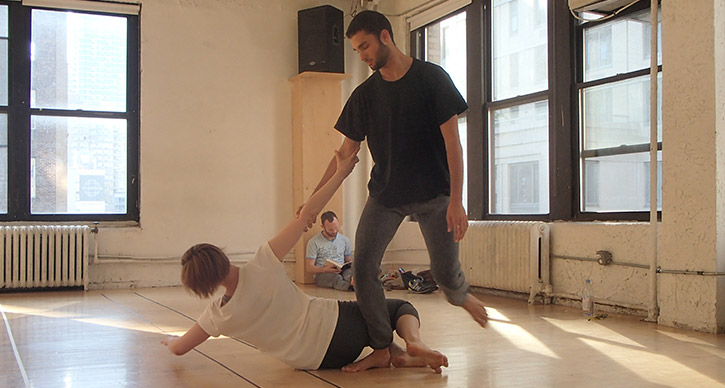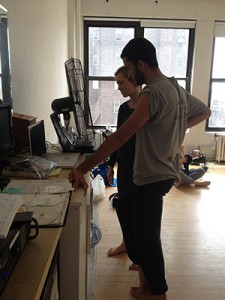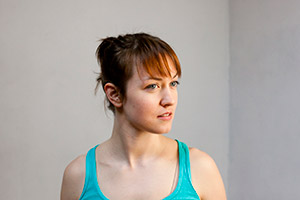Artist Interview: Leah Ives, Trisha Brown Dance Company Dancer

Photo: Trisha Brown Dance Company dancer Leah Ives and fellow dancer Marc Crousillat rehearse a duet from one of many pieces of repertory the two must learn as new members of the Company. Photo by Hillary Kooistra.
The Trisha Brown Dance Company performs in Ann Arbor on February 21-22, 2015. Hillary Kooistra, University of Michigan Dance student and UMS intern, spent five weeks with the company during Summer 2014 as part of a new internship program. During her internship, Hillary had the chance to work with the company on the administrative side and to also sit down with company members and interview them.
Her second interview was with dancer Leah Ives. Leah started dancing with the company in June 2014, and she is also a U-M Dance graduate.
Hillary Kooistra: You’re one of the newer members of the company. Trisha Brown Dance Company is an iconic post-modern company that’s currently in a transition period, and this performance is part of a tour that showcases major stage works. What’s it like to enter rehearsals when the company is in a transition period?
Leah Ives: It’s hard for me to know what it was like for people to enter when the company was not in a transition period. I think we’re very focused on the performances that are coming up, and so in some ways, I imagine that the transition hasn’t fully affected the company quite yet. I feel lucky to be able to jump in and have the chance to perform these works.
I also recognize that this movement hasn’t had as much time to settle into my body and that I have a lot to learn when compared to the other dancers who may have performed these roles and who have had years with these movements and with the pieces settling onto them. I feel like I have a large task to complete in a very short period of time.
HK: Did you always know that you wanted to dance for Trisha Brown?
LI: I was always interested in the company. Once I studied the movement and the repertoire, I found it really satisfying and intriguing mentally. There is a lot of specificity, a lot of attention to detail, and then a lot of of abandoning of that and seeing where that goes in the body.
So yes, I was always interested in the company, but there’s a point when a dancer recognizes that she’s one of many that would love to work for a full-time company, and an iconic company like Trisha Brown Dance Company at that. So, I was content studying the work and getting what I could from the work as a technique, as movement. I am so thrilled to be one of the lucky people who get to actually perform the work.
HK: What are you most excited to share with our Ann Arbor audience? I know the company is doing “Newark” as well as “Set and Reset” (1983).
LI: I’m excited to show the sense of weight and peacefulness in the body that Trisha Brown’s movement is known for. The sort of physics that play through the body in her work may be very different from some of the work that has been presented recently at UMS. I think the pieces we’re performing are really dynamic works, really exciting works, very full of bodies, movement, and interplay between dancers. They’re very exciting pieces to watch.
HK: You graduated from the University of Michigan with a BFA in Dance in 2007. Can you think of work that you did as an undergraduate student at U-M that reminds you of the work you’re currently doing?
LI: While I was there, choreographer Alexandra Beller set a piece with us, and both the interaction between dancers and the grounded-ness of the movement was similar to Trisha Brown’s work. Choreographer Doug Varone also set a piece with us, and the sense of momentum in that piece was very similar to Trisha Brown’s work, the sense of feeling the weight of the arms and the swing through the body. I had also studied with former Trisha Brown Dance Company dancers during the summers and that has really helped me in performing these works.
HK: How is Trisha Browns’s work differed from other dance works that you’ve encountered in your career so far?


Photos: On left, Leah and fellow dancer Marc Crousillat review choreography from a DVD during some downtime in rehearsal. Photo by Hillary Kooistra. On right, Leah Ives. Photo courtesy of the artist.
LI: Trisha’s work is incredibly intricate in a way that I’ve not encountered very often. It’s very visual, the spacing between dancers is incredibly important. Trisha seemed to have a clear vision of what she wanted in each moment, so we are always trying to re-create that vision.
It’s a tricky process because we are looking at one version of that vision from when the work was originally created, and then maybe another version from ten years later and on a different stage and with different people. This process is very different from what I’ve done in the past.; my other projects have mostly been new works. This concept of taking these roles that were created by someone else and were modified through her body, put onto another body that may or may not have affected the role, and then taught to the person who is now teaching me, is a really interesting way of translating movement. It’s a great challenge. I’m not quite there in the rehearsal process yet.
HK: We’re really looking forward to seeing you on stage back in Ann Arbor! Before we end our chat, can you tell us about your most memorable UMS experience while you were at the University?
LI: The most memorable is hard to pick. I was fortunate enough to live fairly close to Ann Arbor growing up. I lived in Brighton, Michigan. So when I was in Middle School, we had a field trip to the Power Center to see Elizabeth Streb’s Dance Company. That was my first experience with modern dance. It was really exciting, especially at that age, to see people flying through space and their use of trampolines and technology (the soundtrack was based on the bouncing). That stuck with me for a long time.
Another experience that stuck with me was during the Royal Shakespeare Company residency. There were many programs beyond their performances, one of which included a competition of interpretations of a sonnet. I had made a dance based on a sonnet and got to perform it for Patrick Stewart. And I didn’t place, but it’s still something I can brag about! It was a great brag-worthy experience.
Read more of Hillary Kooistra’s behind-the-scenes coverage of Trisha Brown Dance Company.







